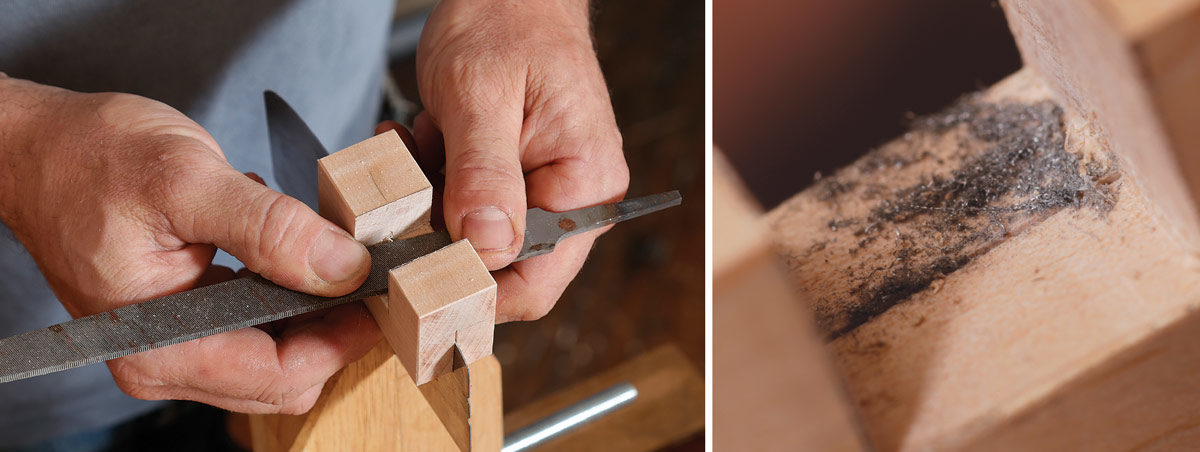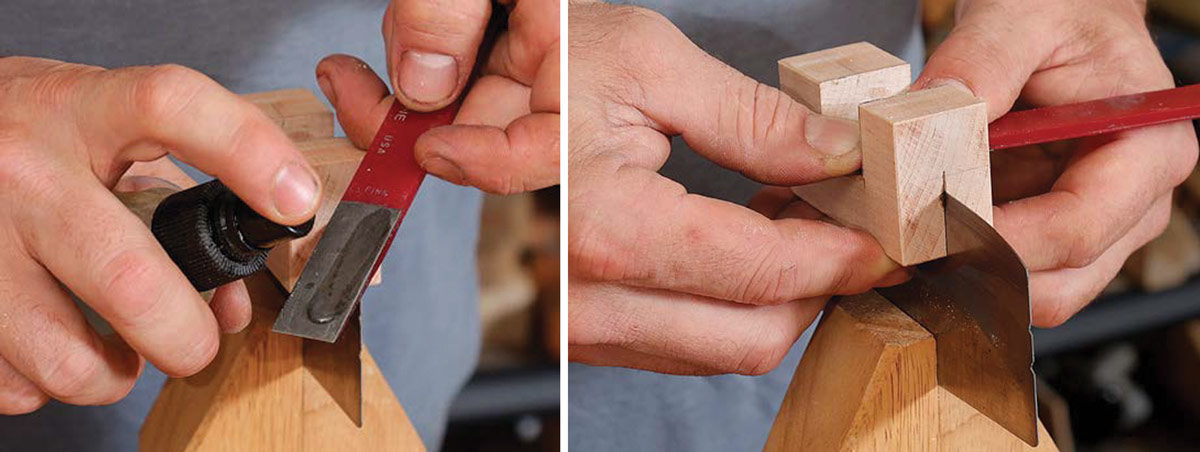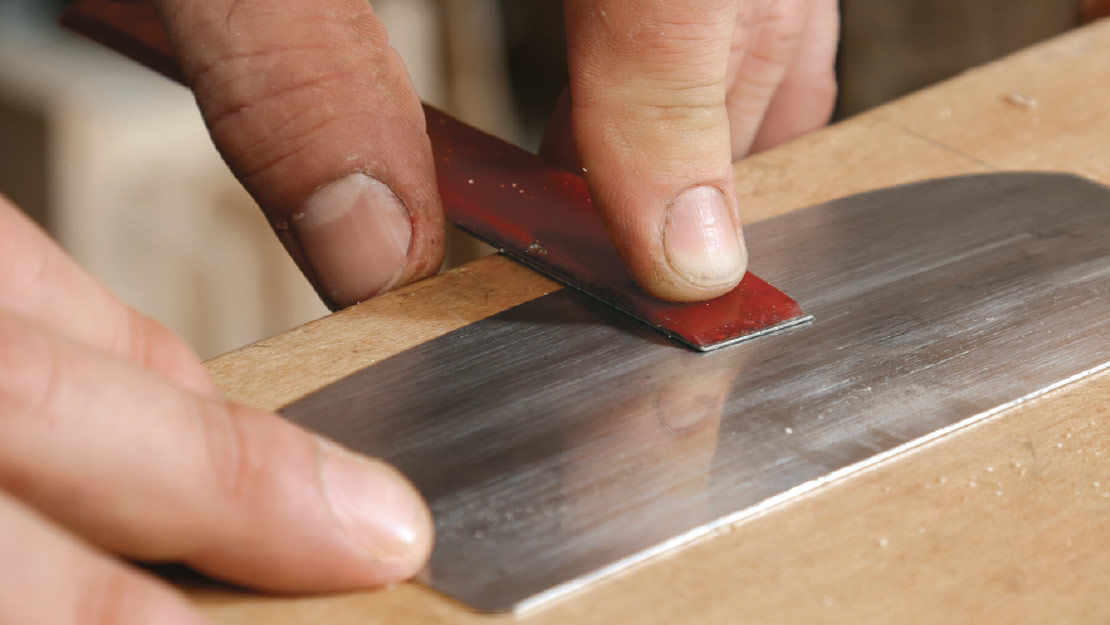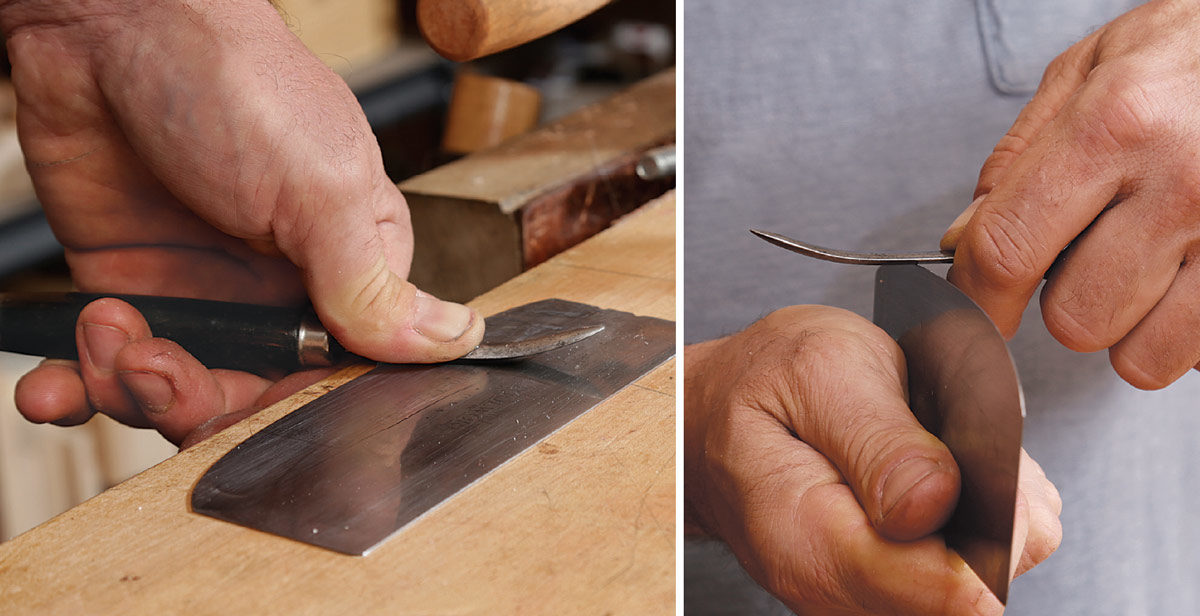Sharpening a Curved Scraper
Peter Galbert demonstrates how to get a perfect edge on a curved card scraper consistently and efficiently.
The card scraper is an indispensable tool in my shop. I was introduced to it as a tool for refining flat surfaces, but I now use it more as a shaping tool to fair curves and dial in complex shapes on chair seats. The soft metal is easy to grind to a curve, and with a simple shopmade honing jig I can maintain a high level of sharpness across the curved edge with speed and repeatability. The cutting edge of any scraper, straight or curved, is a slightly deformed 90° meeting of the flat face of the tool and the edge. While much is said about “turning the burr,” the real attention should be paid to establishing a perfect right-angle relationship between the face and the edge. If these surfaces meet at a sharp 90° angle, the scraper will take a good shaving even without a burr. Adding a burr improves the cutting action from good to beautiful. But if there is any rounding of the underlying edge, there will be little hope for success, regardless of your efforts with the burnisher.
Another important factor, besides having a sharp corner where the surfaces meet, is the condition of the surfaces. When you joint the edge with a file, you’ll attain the correct geometry, but the edge will have grooves left by the file. This might be acceptable for rough work, but the scraped surface will have lots of small scratches. Refining the edge with a diamond hone will yield a smoother surface and a cleaner cut.
Making a curved scraper is simple
Draw a curve on the flat face of a scraper and grind to it. Take care not to let the heat build to the point where the edge blues. Overheating will soften the metal and reduce the life of the edge. After grinding, polish the flat faces on a freshly flattened stone or with fine sandpaper on glass. Then it’s on to filing.
Joint with a file

Using a simple honing jig (in FWW issue #271), put a sharp fine file in the notch and pinch the file against the bottom of the notch. Skew the file so it cuts on the diagonal. Insert the scraper in the slot and draw the jig toward you using very light pressure. If the edge has been burnished previously, the metal will be compressed and hard, and it may take a few strokes to reach the softer metal beneath. Small curly shavings will peel off the edge when you are through the tough stuff.
Use a diamond hone to further refine the edge

To refine the edge further, use the jig again, but now with a fine diamond hone. Then, with the scraper laid flat, us the diamond hone on both sides, and use it on the edge once more with the jig.

Now turn the burr
Lay the scraper flat on a hard surface, press an oiled burnisher flat on the side, and take several passes. This step points the burr toward the edge. Next hold the scraper with the cutting edge up and position the burnisher 90° to the face. Draw the burnisher down the edge. On the next pass, tilt the burnisher a degree or two toward the side you are sharpening. It’s the pressure of the tool, not an extreme angle, that turns the soft metal to a burr. Once you feel a tiny burr along the entire edge, stop and test the tool.

When this burr becomes dull, you can turn a new one. In subsequent burnishings the soft material will get harder, making a burr that lasts longer, but at some point it will get too difficult to distort into a fresh burr and the process must start again with the file to remove the hardened material.
Check out Peter’s article on how to make his jig in FWW #271!
More on FineWoodworking.com:








Comments
Excellent, thank you Peter.
Great video, but flawed! I watched 3 times... when Peter "turns the burr" (hook) on the scraper he picks up a tool and does not mention it or name it. Not even a good close-up of the tool. The written info says it is a "burnisher"... what is it & from where does it come?
Great video! Very cool technique with great results on pine, which is not usually very scraper friendly.
Thanks Pete!
I was having issues getting my scraper sharp. I made the jig and gave it a try it worked great, scraper is now working awesome
thanks for the video... i absolutely love using scrapers, but have difficulty sharpening ones that are curved inward (concave). i make lots of Queen Anne legs and use a scraper that has a curve whose diameter is the size of a half dollar and one the size of a quarter... have not found a good way to do those...
Peter, this is a very great demonstration. I do have a question. It is about the sled you used. It is an interesting addition and probably a secret your success.
How did you make the slide, what is the size and what material did you use?
Len G. Vancouver BC
He give all of that info in his article from that issue: https://www.finewoodworking.com/2018/09/26/how-to-sharpen-and-use-a-curved-scraper
Log in or create an account to post a comment.
Sign up Log in